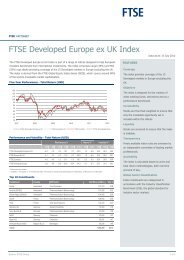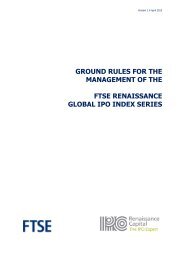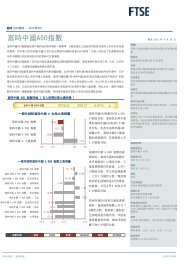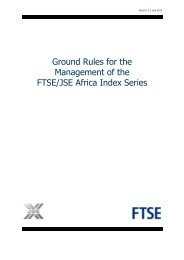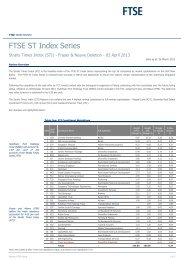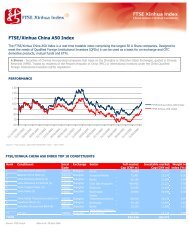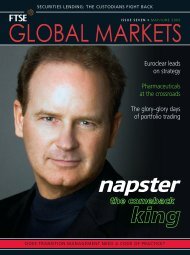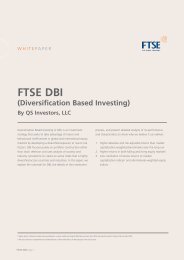You also want an ePaper? Increase the reach of your titles
YUMPU automatically turns print PDFs into web optimized ePapers that Google loves.
customers additional accounts. On top of that, its expenses<br />
are well above industry standards.<br />
Instead what Commerce does is focus on attracting<br />
consumer depositors with an array of conveniences,<br />
gimmicks and services that other banks do not offer [or, at<br />
least do not make a big<br />
deal about]. Most visibly,<br />
Commerce keeps longer<br />
hours, including opening<br />
on Sunday, than virtually<br />
all of its competitors. It<br />
lures people into its<br />
branches with free coin<br />
counting machines.<br />
Branches are stocked with<br />
dog biscuits for customers<br />
who bring their pets in.<br />
And the bank will take care<br />
of all the rote work<br />
associated with moving<br />
online banking and bill<br />
payment from a<br />
competitor’s account. The<br />
many touches – or<br />
“extreme culture” and<br />
“fanatical execution,” in Hill’s words – seem to add up in<br />
the minds of consumers.<br />
“Commerce has differentiated itself from the other<br />
players,” says Charles B. Wendel, a banking industry<br />
consultant in New York. And that is something few other<br />
banks have done, he adds. While banks endlessly proclaim<br />
that they care about their customers or that they are their<br />
customers’ friend, Commerce is unusual in backing its<br />
words up with delivery of a distinctly different level of<br />
service, he explains.<br />
And that is exactly the idea.“The customer cares about<br />
the retail experience, rather than the highest rate,”Hill said<br />
recently, during a visit to a mid-town Manhattan branch<br />
that sits not much more than 100 metres from offices<br />
owned by the four largest US banking companies, Citi,<br />
Chase, Bank of America Corp. and Wachovia Corp. Indeed,<br />
seemingly illustrating the point, the branch, on Avenue of<br />
the Americas at 55th Street, has booked $267m in deposits<br />
since it opened in September 2001 – a large number for a<br />
mature office, let alone one less than four years old. In fact,<br />
beyond the results of one particular branch, Hill appears to<br />
be building a business around the premise that if a bank<br />
willingly, maybe even eagerly, pays for all the pieces of an<br />
attractive retail experience, then customers will not mind<br />
that the bank does not pay especially competitive interest<br />
on deposit accounts. With low-cost deposits flooding into<br />
new branches and flowing at a more measured pace into<br />
mature branches, Commerce is able to maintain relatively<br />
good interest-rate margins. Then, as long as overall deposit<br />
levels grow rapidly, earnings grow at a fast clip as well.<br />
US consumers, Hill asserts, are nearly universal in their<br />
dislike for their banks, making it rather easy to peel them<br />
350<br />
300<br />
250<br />
200<br />
150<br />
100<br />
<strong>FTSE</strong> GLOBAL MARKETS • JULY/AUGUST 2005<br />
The quest for growth – turning an “amazing customer<br />
experience” into an “amazing investor experience” –<br />
Commerce Bancorp vs. US Banks<br />
50<br />
0<br />
away. Even commercial business is drawn in by Commercestyle<br />
retailing, Hill says, explaining that owners of small and<br />
mid-sized businesses are not going to stay with banks<br />
where their spouses or children have bad experiences.<br />
Hill, 59, launched the bank in 1973 when he was only 27<br />
Apr-00<br />
Oct-00<br />
Apr-01<br />
Oct-01<br />
Apr-02<br />
Oct-02<br />
Apr-03<br />
Oct-03<br />
Apr-04<br />
Oct-04<br />
Apr-05<br />
Commerce Bancorp NJ Citigroup JPMorgan Chase & Co<br />
Bank of America <strong>FTSE</strong> US Banks <strong>Index</strong><br />
Data as at June 05. Source: <strong>FTSE</strong> Group/FactSet Limited.<br />
years old, after running a<br />
site development business<br />
for a few years for retail<br />
chains such as<br />
McDonald’s Corp. In<br />
addition to his 4.46%<br />
stake in Commerce, he is a<br />
partner in a group that owns<br />
47 Burger King restaurants<br />
in the Philadelphia area.<br />
He says that he thought<br />
from the beginning that a<br />
government charter,<br />
effectively a license to<br />
accept deposits, nearly<br />
guaranteed that he would<br />
make money. He did not<br />
always expect that his<br />
bank would grow so large.<br />
But now he is so confident<br />
that he is practically daring competitors to stop him.<br />
With a base in the suburbs of Philadelphia, and now 178<br />
branches in the New York City area, Hill expects to open 10<br />
to 15 branches in and around Washington this year and 200<br />
over the next few years. He has said that either the Boston<br />
area or Florida will be next; analysts expect him to<br />
announce which it will be this summer. One of the big<br />
reasons that he can march into new markets, he says<br />
brashly, is that so many competitors do more to annoy their<br />
customers than please them with their constant mergers<br />
and acquisitions. “My competitors are in the cost-cutting<br />
business,”Hill says.“I’m in the top-line growth business.”<br />
Whether the characterisations are fair or not, Commerce<br />
has performed quite well. It has produced an annual<br />
average return to shareholders of 31% over both five and<br />
10 years through the end of March. That compared to<br />
compound annual average decline of 3% for the Standard<br />
& Poor’s 500 over the past five years and an 11% annual<br />
gain for the S&P 500 over a 10-year period.<br />
The big question for investors, however, is whether<br />
Commerce can keep up the pace – of apparently successful<br />
new branch openings, of entry into new markets and of<br />
continued growth in its longer-standing markets – or<br />
whether competitors learn to do a better job of holding<br />
onto their customers. At $28 in mid-May, the company’s<br />
stock traded on the New York Stock Exchange for about 16<br />
times the trailing 12 months’ earnings, suggesting healthy,<br />
but unspectacular, expectations of investors.<br />
A common view among analysts who follow Commerce<br />
is that the company has at least several good years of<br />
industry-leading growth ahead. “They are very good at<br />
taking market share,” said Claire M. Percarpio, an analyst<br />
79



